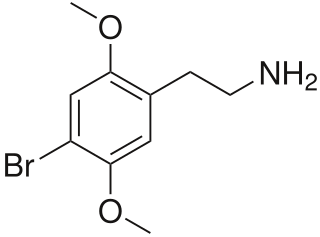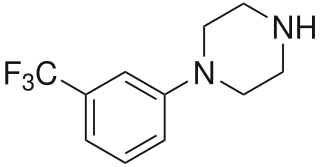
3,4-Methylenedioxymethamphetamine (MDMA), commonly known as ecstasy, and molly or mandy, is a potent empathogen–entactogen with stimulant and minor psychedelic properties. Investigational indications include as an adjunct to psychotherapy in the treatment of post-traumatic stress disorder (PTSD) and social anxiety in autism spectrum disorder. The purported pharmacological effects that may be prosocial include altered sensations, increased energy, empathy, and pleasure. When taken by mouth, effects begin in 30 to 45 minutes and last three to six hours.

Harm reduction, or harm minimization, refers to a range of intentional practices and public health policies designed to lessen the negative social and/or physical consequences associated with various human behaviors, both legal and illegal. Harm reduction is used to decrease negative consequences of recreational drug use and sexual activity without requiring abstinence, recognizing that those unable or unwilling to stop can still make positive change to protect themselves and others.

Club drugs, also called rave drugs or party drugs, are a loosely defined category of recreational drugs which are associated with discothèques in the 1970s and nightclubs, dance clubs, electronic dance music (EDM) parties, and raves in the 1980s to today. Unlike many other categories, such as opiates and benzodiazepines, which are established according to pharmaceutical or chemical properties, club drugs are a "category of convenience", in which drugs are included due to the locations they are consumed and/or where the user goes while under the influence of the drugs. Club drugs are generally used by adolescents and young adults.
Needle sharing is the practice of intravenous drug-users by which a needle or syringe is shared by multiple individuals to administer intravenous drugs such as heroin, steroids, and hormones. This is a primary vector for blood-borne diseases which can be transmitted through blood. People who inject drugs (PWID) are at an increased risk for Hepatitis C (HCV) and HIV due to needle sharing practices. From 1933 to 1943, malaria was spread between users in the New York City area by this method. Afterwards, the use of quinine as a cutting agent in drug mixes became more common. Harm reduction efforts including safe disposal of needles, supervised injection sites, and public education may help bring awareness on safer needle sharing practices.

2C-B (4-bromo-2,5-dimethoxyphenethylamine) is a synthetic psychedelic drug of the 2C family, mainly used as a recreational drug. The substance was first synthesized by Alexander Shulgin in 1974, and gained an initial reputation for potential psychotherapeutic use, but its use has been limited to mainly recreational use. To date, there is limited scientific information regarding the drug's pharmacokinetics and pharmacological effects in humans. The existing studies primarily classify 2C-B as a stimulant, and hallucinogen, and less commonly as an entactogen, and empathogen.

Erowid, also called Erowid Center, is a non-profit educational organization that provides information about psychoactive plants and chemicals.
A drug test is a technical analysis of a biological specimen, for example urine, hair, blood, breath, sweat, or oral fluid/saliva—to determine the presence or absence of specified parent drugs or their metabolites. Major applications of drug testing include detection of the presence of performance enhancing steroids in sport, employers and parole/probation officers screening for drugs prohibited by law and police officers testing for the presence and concentration of alcohol (ethanol) in the blood commonly referred to as BAC. BAC tests are typically administered via a breathalyzer while urinalysis is used for the vast majority of drug testing in sports and the workplace. Numerous other methods with varying degrees of accuracy, sensitivity, and detection periods exist.

3-Trifluoromethylphenylpiperazine (TFMPP) is a recreational drug of the phenylpiperazine chemical class and is a substituted piperazine. Usually in combination with benzylpiperazine (BZP) and other analogues, it is sold as an alternative to the illicit drug MDMA ("Ecstasy").

2,5-Dimethoxy-4-chloroamphetamine (DOC) is a psychedelic drug of the phenethylamine and amphetamine chemical classes. It was presumably first synthesized by Alexander Shulgin, and was described in his book PiHKAL.

Drug injection is a method of introducing a drug into the bloodstream via a hollow hypodermic needle, which is pierced through the skin into the body. Intravenous therapy, a form of drug injection, is universally practiced in modernized medical care. As of 2004, there were 13.2 million people worldwide who self-administered injection drugs outside of medical supervision, of which 22% are from developed countries.

Reagent testing is one of the processes used to identify substances contained within a pill, usually illicit substances. With the increased prevalence of drugs being available in their pure forms, the terms "drug checking" or "pill testing" may also be used, although these terms usually refer to testing with a wider variety of techniques covered by drug checking.
Illicit drug use in Australia is the recreational use of prohibited drugs in Australia. Illicit drugs include illegal drugs, pharmaceutical drugs when used for non-medical purposes, and other substances used inappropriately. According to government and community organisations, the use and abuse, and the illegality, of illicit drugs is a social, health and legal issue that creates an annual illegal market estimated to be worth A$6.7 billion. Estimates made in 2022 place the figure at A$11.3 billion per year.
Responsible drug use seeks to maximize the benefits and minimize the risks associated with psychoactive drug use. For illegal psychoactive drugs that are not diverted prescription controlled substances, some critics believe that illegal recreational drug use is inherently irresponsible, due to the unpredictable and unmonitored strength and purity of the drugs and the risks of addiction, infection, and other side effects.
Amphetamine and methamphetamine are central nervous system stimulants used to treat a variety of conditions. When used recreationally, they are colloquially known as "speed" or sometimes "crank". Amphetamine was first synthesized in 1887 in Germany by Romanian chemist Lazăr Edeleanu, who named it phenylisopropylamine. Around the same time, Japanese organic chemist Nagai Nagayoshi isolated ephedrine from the Chinese ephedra plant and later developed a method for ephedrine synthesis. Methamphetamine was synthesized from ephedrine in 1893 by Nagayoshi. Neither drug had a pharmacological use until 1934, when Smith, Kline & French began selling amphetamine as an inhaler under the trade name Benzedrine for congestion.
Bluelight is a web-forum, research portal, online community, and non-profit organization dedicated to harm reduction in drug use. Its userbase includes current and former substance users, academic researchers, drug policy activists, and mental health advocates. It is believed to be the largest online international drug discussion website in the world. As of February 2024, the website claims over 465,000 registered members.
Eve & Rave are/were non-profit registered associations in the German cities Berlin, Kassel, Cologne and Münster as well as in Switzerland. The name of these associations is a composition of the words "eve" like some sort of ecstasy-pills and "rave" like the correspondent electronic music events.
Drug checking or pill testing is a way to reduce the harm from drug consumption by allowing users to find out the content and purity of substances that they intend to consume. This enables users to make safer choices: to avoid more dangerous substances, to use smaller quantities, and to avoid dangerous combinations.
Harm reduction consists of a series of strategies aimed at reducing the negative impacts of drug use on users. It has been described as an alternative to the U.S.'s moral model and disease model of drug use and addiction. While the moral model treats drug use as a morally wrong action and the disease model treats it as a biological or genetic disease needing medical intervention, harm reduction takes a public health approach with a basis in pragmatism. Harm reduction provides an alternative to complete abstinence as a method for preventing and mitigating the negative consequences of drug use and addiction.
The Trans-European Drug Information (TEDI) project is a European database compiling information from different drug checking services located on the European continent. The non-governmental organizations feeding into the database are referred to as the TEDI network.









